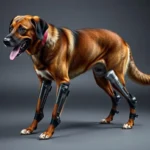
Introduction
Dog health care is a fundamental aspect of responsible pet ownership and plays a crucial role in ensuring our furry friends lead happy, healthy lives. Among various health issues that can affect dogs, hip dysplasia in dogs stands out due to its prevalence and potential impact on quality of life.
Hip dysplasia is a genetic condition where the hip joint doesn’t fit into the hip socket properly, resulting in pain, arthritis, and decreased mobility. This condition is particularly significant in certain breeds, such as German Shepherds, Labrador Retrievers, and Golden Retrievers, who are more genetically predisposed. In this article, we aim to educate dog owners about hip dysplasia, including its symptoms, causes, prevention strategies, and treatment options available.
Understanding Hip Dysplasia
What is Hip Dysplasia?
Hip dysplasia in dogs is a developmental disorder that affects the hip joint, specifically the ball-and-socket structure. In a healthy dog, the femoral head (the ball) fits snugly into the acetabulum (the socket). However, in dogs with hip dysplasia, the fit is loose, which can lead to joint instability, pain, and inflammation over time. This condition can manifest in various degrees of severity, and while some dogs may show no symptoms, others can suffer significantly.
Causes of Hip Dysplasia
Genetic Factors
Hip dysplasia is primarily influenced by genetic factors. Certain breeds have a higher predisposition to developing this condition due to inherited traits. Common breeds affected include:
- German Shepherds
- Labrador Retrievers
- Golden Retrievers
- Rottweilers
- Bulldogs
It’s essential for potential dog owners to consider breed predispositions when selecting a pet.
Environmental Factors
While genetics play a significant role, environmental factors can also contribute to the development of hip dysplasia. These include:
-
Nutrition and Obesity: Overfeeding and providing a diet high in calories can lead to obesity, which places additional stress on a dog’s joints, exacerbating hip dysplasia.
-
Impact of Exercise: Puppies that engage in excessive or inappropriate exercise during their growth phase may be at risk for developing hip dysplasia. It’s crucial to tailor exercise regimens based on age and developmental stage.
Symptoms of Hip Dysplasia
Early Signs and Symptoms
Detecting hip dysplasia early can be challenging, but some initial signs include:
- Difficulty in rising, jumping, or climbing stairs
- Reluctance to walk or run, particularly after rest
Progressive Symptoms
As the condition worsens, additional symptoms may emerge, including:
- Limping or lameness, particularly after activity
- Decreased activity levels or reluctance to engage in play
Other Indicators
Changes in behavior can also indicate discomfort. Affected dogs may become irritable or withdrawn. Observing these changes is crucial for timely intervention.
Diagnosis of Hip Dysplasia
Veterinary Examination
Regular veterinary check-ups are vital for maintaining your dog’s health. During these visits, veterinarians perform physical examinations that can help detect signs of hip dysplasia. They will assess your dog’s range of motion and look for signs of pain or discomfort in the hip area.
Diagnostic Imaging
To confirm a diagnosis, veterinarians may use diagnostic imaging techniques, such as:
-
X-rays: These are the most common method to evaluate hip joints. X-rays can reveal the degree of joint laxity and any changes associated with hip dysplasia.
-
Advanced Imaging Techniques: In some cases, veterinarians may recommend MRI or CT scans for a more detailed view of the joint structure. These advanced methods provide additional information that can guide treatment decisions.
Interpreting the results is key to developing an effective treatment plan.
Treatment Options for Hip Dysplasia
Conservative Management
In many cases, conservative management can significantly improve the quality of life for dogs with hip dysplasia. This includes:
-
Weight Management and Dietary Modifications: Maintaining a healthy weight is critical. A balanced diet low in calories can help manage your dog’s weight and reduce stress on the joints.
-
Physical Therapy and Rehabilitation Exercises: Tailored exercise programs can strengthen muscles around the hip joint, improving stability and reducing discomfort.
-
Pain Management: Medications such as NSAIDs (non-steroidal anti-inflammatory drugs) can help alleviate pain. Supplements like glucosamine and chondroitin may also support joint health.
Surgical Interventions
In severe cases of hip dysplasia, surgical intervention may be necessary. Common surgical options include:
-
Femoral Head Osteotomy (FHO): This procedure involves removing the femoral head to eliminate painful contact between the bones, allowing scar tissue to form and create a false joint.
-
Total Hip Replacement: This is a more invasive procedure where the damaged hip joint is replaced with a prosthetic joint. It is typically reserved for dogs with severe joint damage.
The decision to pursue surgery depends on the severity of the condition and the dog’s overall health. Recovery and post-operative care are critical for successful outcomes.
Alternative Treatments
In addition to traditional treatments, some dog owners explore alternative therapies, including:
-
Acupuncture and Chiropractic Care: These therapies can provide pain relief and improve mobility.
-
Use of Braces or Support Devices: Specialized braces can help stabilize the hip joint and provide support during activities.
-
Therapeutic Laser Treatment: This non-invasive treatment promotes healing and reduces inflammation in affected joints.
Prevention of Hip Dysplasia
Responsible Breeding Practices
Preventing hip dysplasia begins with responsible breeding practices. It is essential to select a reputable breeder who screens for hip dysplasia and conducts genetic testing. This ensures that potential puppies come from healthy lineages.
Puppy Care
Proper care during the puppy stage is vital. Here are some tips:
-
Nutrition Tips: Provide a well-balanced diet specifically formulated for puppies to ensure healthy growth without excess weight gain.
-
Appropriate Exercise Regimens: Engage in age-appropriate exercise. Avoid high-impact activities until your puppy is fully grown.
Adult Dog Care
Maintaining a healthy lifestyle for adult dogs is equally important:
-
Maintaining a Healthy Weight: Regularly monitor your dog’s weight and adjust their diet as needed to prevent obesity.
-
Regular Exercise and Activity Levels: Consistent, moderate exercise helps maintain joint health and muscle strength.
-
Routine Veterinary Check-ups: Regular visits to the vet can help detect any early signs of hip dysplasia or other health issues, allowing for prompt intervention.
Living with a Dog with Hip Dysplasia
Adjusting Home Environment
Creating a comfortable living environment is essential for dogs with hip dysplasia. Consider making the following adjustments:
-
Creating a Comfortable Living Space: Provide soft bedding and a quiet area for your dog to rest.
-
Modifications for Easier Mobility: Install ramps to help your dog navigate stairs and use non-slip surfaces to prevent slips and falls.
Emotional and Psychological Care
Understanding that your dog may experience changes in behavior due to discomfort is crucial. Offering emotional support can make a significant difference:
-
Providing Mental Stimulation: Engage your dog with puzzle toys, training exercises, and gentle play to keep their mind active.
-
Companionship: Spend quality time with your dog to reassure them and alleviate potential anxiety or stress related to their condition.
Conclusion
Understanding and managing hip dysplasia in dogs is vital for promoting a better quality of life for our furry companions. By recognizing the symptoms, seeking early diagnosis, and exploring treatment options, dog owners can significantly improve their pets’ comfort and mobility.
Being proactive about health care, from responsible breeding practices to lifestyle adjustments, is key to preventing and managing this condition. Ultimately, providing proper care and attention can lead to a happier and healthier life for dogs affected by hip dysplasia.
Call to Action
We encourage dog owners to share their experiences with hip dysplasia in dogs. Staying informed about the latest veterinary recommendations and research updates can be beneficial. Engaging with support groups can also provide valuable insights and encouragement for those navigating this condition with their pets.









